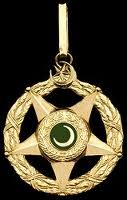| Hilal-e-Imtiyaaz ہلالِ امتیاز | |
|---|---|
 Hilāl-e-Imtiyāz | |
Awarded by  Government of Pakistan | |
| Type | Award |
| Ribbon | Hilal-e-Imtiaz (Civilian) Hilal-e-Imtiaz (Military) |
| Eligibility | Pakistani or Foreign citizen |
| Awarded for | The highest degree of service to the state, and for services to international diplomacy. |
| Status | Currently constituted |
| Sovereign | President of Pakistan |
| Sovereign | Prime minister of Pakistan |
| Grades | 5 grade: Star (1st Class) Badge (Second Class) Ribbon (military only) Collar Chain (4th class) Medal (5th Class)[1] |
| Statistics | |
| First induction | 19 March 1957 |
| Precedence | |
| Next (higher) | |
| Next (lower) | |
The Hilaal-e-Imtiaz (Urdu: ہلالِ امتیاز, lit. 'Crescent of Excellence'; pronounced [hɪ.lɑː.lɪ ɪm.t̪ɪ.jɑːz]), also spelled and transliterated as Hilāl-e-Imtiyāz, is the second-highest (in the hierarchy of "Hilal")[2] civilian award and honour given to both civilians and military officers of the Pakistan Armed Forces by the Government of Pakistan. It recognises individuals who have made an "especially meritorious contribution to the security or national interests of Pakistan, world peace, cultural or other significant public endeavors". It is a civilian award, and not limited to the citizens of Pakistan.
The honour is restricted to individuals who have made outstanding contributions in their fields that led to international recognition for the state. It is awarded in the fields of literature, arts, sports, medicine and science for civilians. It is announced every year on Independence Day (14 August), and given on Pakistan Day, 23 March, by the President of Pakistan.
For officers in the military, it is given for distinguished service. The first Hilal e Imtiaz Military in the history of Pakistan was awarded by PM ZA Bhutto to 4 star General Zia ul Haq after Zia was appointed Chief of the Army in 1976. Initially awarded exclusively to officers reporting directly to the Secretary of Defense, after 1979 it began to be award in a new format to officers who were up to two steps removed from the Secretary of Defense, such as Major General or Lieutenant General (Army), Air Vice-Marshals or Air Marshals (Air Force) and Rear-Admiral or Vice-Admiral (Navy, Coast Guard, and Marines). The Parliament's committee for award and recognition services selects the names of individuals and sends their report to the prime minister; on his advice, the president announces the awards in a ceremony that is broadcast by PTV. The award is usually given to individuals, not groups, because the purpose of the award is to recognise the recipients' individual contributions.
The award is a disc of golden jasminum between the five points of a pure gold star. The star has additional bright jasminum; in its centre there is a green emerald with a golden crescent.
A special grade of the medal has a larger execution of the same medal design worn as a star on the left of the chest. In addition, it is worn as a sash on the right shoulder, with its rosette (yellow with white for civilians and green for military officers) and white and yellow edge bearing the central disc of the medal at its centre, resting on the left hip. At the ceremony, both medals can be worn at the same time according to their achievements. The medal is suspended on a dark green ribbon with a light yellow and white central stripe and white edge stripes.
Military officers who receive the award are given a Non-Prohibited Bore Arms License.
- ^ All these items are usually given all together. Only military officers from the Pakistan Defence Forces are awarded the ribbon which is attached to their uniform.
- ^ "Civilian Awards - Emerging Pakistan". Emerging Pakistan. 1 July 2020. Archived from the original on 1 July 2020. Retrieved 16 July 2021.